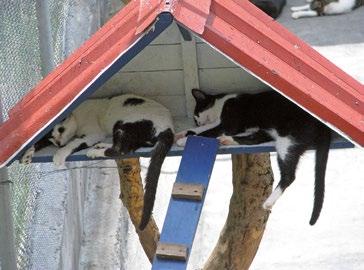DISORDERS ASSOCIATED WITH ENVIRONMENTAL STRESS
CAT STEREOTYPIES
2
TREATMENT Treatment is based on establishing a combination of behavioural therapy, adjusting the animal’s environment, and drug treatment.
BEHAVIOURAL THERAPY Behavioural therapy consists of: ➤ Counterconditioning: this involves teaching the animal a behaviour that is incompatible with the stereotypy. ➤ Distraction from the behaviour: attracting the animal’s attention when it is engrossed in the stereotypy using noises, food, toys, and so on. ➤ Systematic desensitisation: entails progressively introducing the stim‑ ulus that triggers the stereotypy, the aim being to gradually cause the animal less anxiety. ➤ Aversion therapy: this is a behavioural modification technique through which the cat associates its behaviour with an unpleasant consequence (e.g. using devices that expel compressed air and make a sound, by applying bitter substances to the site where the animal compulsively licks itself, etc.).
MODIFICATION OF THE PATIENT’S ENVIRONMENT The first step is to clearly identify the triggering stimulus of the stereotypy, so it may be withdrawn before changing the animal’s routine.
INTERACTION WITH THE OWNER Many owners either directly punish or hug and stroke their cats when they exhibit the compulsive behaviour, which only serves to reinforce the ste‑ reotypy. Therefore, it is very important to instruct the owner to ignore the animal’s behaviour and distract the animal with a game; they should never exert a direct punishment. It is essential that the owner changes the way they deal with their pet if they are interacting incorrectly.
37


